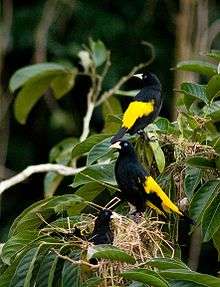Yellow-rumped cacique
The yellow-rumped cacique (Cacicus cela) is a passerine bird in the New World family Icteridae. It breeds in much of northern South America from Panama and Trinidad south to Peru, Bolivia and central Brazil. However, they have been sighted as far north as Nayarit state in Mexico.
| Yellow-rumped cacique | |
|---|---|
.jpg) | |
| in Brazil | |
| Scientific classification | |
| Kingdom: | Animalia |
| Phylum: | Chordata |
| Class: | Aves |
| Order: | Passeriformes |
| Family: | Icteridae |
| Genus: | Cacicus |
| Species: | C. cela |
| Binomial name | |
| Cacicus cela | |
 | |
| Global range (green) | |
| Synonyms | |
| |
Description
The male is on average 28 centimetres (11 in) long and weighs about 104 grams (3.7 oz), with the female 23 centimetres (9.1 in) long and weighing approximately 60 grams (2.1 oz). The yellow-rumped cacique is a slim bird, with a long tail, blue eyes, and a pale yellow pointed bill. It has mainly black plumage, apart from a bright yellow rump, tail base, lower belly and wing "epaulets". The female is duller black than the male, and the juvenile bird resembles the female, but has dark eyes and a brown bill base.
The song of the male yellow-rumped cacique is a brilliant mixture of fluting notes with cackles, wheezes and sometimes mimicry. There are also many varied calls, and an active colony can be heard from a considerable distance.[2]
It has three subspecies:
- Cacicus cela cela – East of the Andes, from the Santa Marta coast of Colombia to central Bolivia and eastern Brazil.
- Cacicus cela vitellinus – Panama Canal Zone to the base of the Sierra Nevada de Santa Marta and the central Magdalena Valley of Colombia. First recorded in the Serranía de las Quinchas on January 17, 2006.[3]
- Cacicus cela flavicrissus – Eastern Andes foothills from Esmeraldas Province (Ecuador) to Tumbes Province (Peru).
The latter two may be a separate species, saffron-rumped cacique.[4]
Ecology

The yellow-rumped cacique is a bird associated with open woodland or cultivation with large trees. This gregarious bird eats large insects and fruit.
It is a colonial breeder, with up to 100 bag-shaped nests in a tree, which usually also contains an active wasp nest. The females build the nests, incubate, and care for the young. Each nest is 30–45 cm long and widens at the base, and is suspended from the end of a branch. Females compete for the best sites near the protection of the wasp nest. The normal clutch is two dark-blotched pale blue or white eggs. Females begin incubating after laying the second egg; hatching occurs after 13 or 14 days. The young fledge in 34 to 40 days, usually only one per nest.
Relationship with humans
The yellow-rumped cacique has benefited from the more open habitat created by forest clearance and ranching. It is not considered threatened by the IUCN.[5]
In Peruvian folklore, this species – like other caciques and oropendolas – is called paucar, or – referring to this species only – paucarcillo ("little paucar"). This species is apparently the paucar that, according to a folktale of Moyobamba, originated as a rumor-mongering boy who always wore black pants and a yellow jacket. When he spread an accusation against an old woman who was a fairy in disguise, she turned him into a noisy, wandering bird. The bird's appearance is thought to augur good news.[6]
Footnotes
- BirdLife International (2012). "Cacicus cela". IUCN Red List of Threatened Species. 2012. Retrieved 26 November 2013.CS1 maint: ref=harv (link)
- Jaramillo & Burke (1999)
- Cuervo et al. (2006)
- Jaramillo & Burke (1999)
- BLI (2008)
- moyobamba.com (2007), Enjoy Peru [2008]
References
- Cuervo, Andrés M.; Hernández-Jaramillo, Alejandro; Cortés-Herrera, José Oswaldo & Laverde, Oscar (2007): Nuevos registros de aves en la parte alta de la Serranía de las Quinchas, Magdalena medio, Colombia [New bird records from the highlands of Serranía de las Quinchas, middle Magdalena valley, Colombia]. Ornitología Colombiana 5: 94–98 [Spanish with English abstract]. PDF fulltext
- Enjoy Peru [2008]: Manu – Aves. Retrieved 2008-DEC-22.
- moyobamba.com (2007): Leyendas e historia de los barrios. Retrieved 2007-SEP-28.
Further reading
- ffrench, Richard; O'Neill, John Patton & Eckelberry, Don R. (1991): A guide to the birds of Trinidad and Tobago (2nd edition). Comstock Publishing, Ithaca, N.Y.. ISBN 0-8014-9792-2
- Hilty, Steven L. (2003): Birds of Venezuela. Christopher Helm, London. ISBN 0-7136-6418-5
- Jaramillo, Alvaro & Burke, Peter (1999): New World Blackbirds. Christopher Helm, London. ISBN 0-7136-4333-1
External links
- Yellow-rumped cacique videos, photos and sounds – Internet Bird Collection
- Yellow-rumped cacique photo gallery – VIREO
